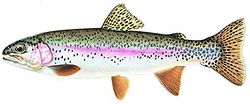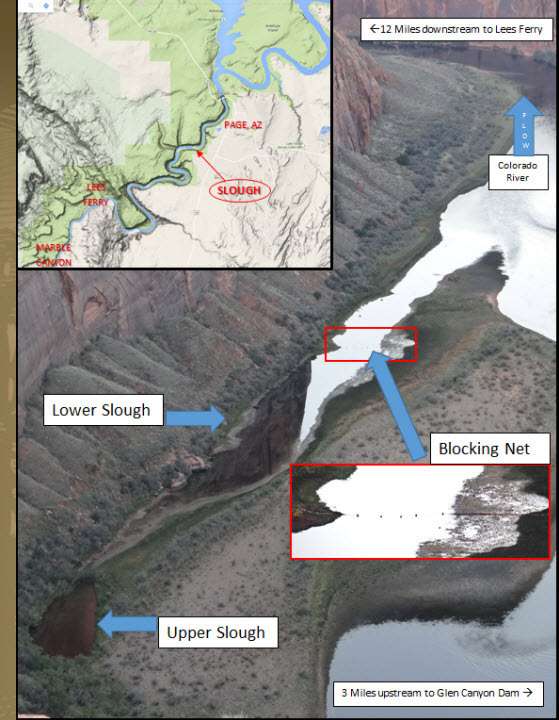Difference between revisions of "Green Sunfish Page"
Cellsworth (Talk | contribs) |
Cellsworth (Talk | contribs) |
||
| Line 145: | Line 145: | ||
Summary of an email from Melissa Trammell (NPS) 9/7/16: | Summary of an email from Melissa Trammell (NPS) 9/7/16: | ||
| − | Melissa has been looking into deriving a defensible acceptable risk number of green sunfish in the lower slough before conducting an HFE this year. She has been evaluating some work done by retired FWS biologist Pat Martinez who has done extensive evaluating illegal introductions of nonnative fish into various water bodies in the upper Colorado River Basin by looking at how many introductions and the number of fish per introduction were necessary before populations became established. The species Martinez examined were walleye, smallmouth bass, and northern pike; invasive species of concern in the upper Colorado River Basin. Green sunfish are most analogous to smallmouth bass in this example. If you look at slide 11 [[media:Propagule-melissa-2016.pdf| in his ppt]], Martinez calculated that it took a mean of 1.25 adult SMB (a minimum of 0.25 SMB) per surface acre of receiving water body, to establish a population in the waterbodies he evaluated. He applied this value to rivers, particularly the Yampa River, by looking at total river miles times average width to get total surface acres. The point of the analysis was that the Program's removal targets for smallmouth bass for the Yampa River were about the same as the mean number needed for establishing a population, which indicated the Program needed to adjust their removal targets down. | + | Melissa has been looking into deriving a defensible acceptable risk number of green sunfish in the lower slough before conducting an HFE this year. She has been evaluating some work done by retired FWS biologist Pat Martinez who has done extensive work evaluating illegal introductions of nonnative fish into various water bodies in the upper Colorado River Basin by looking at how many introductions, and the number of fish per introduction, were necessary before populations became established. The species Martinez examined were walleye, smallmouth bass, and northern pike; invasive species of concern in the upper Colorado River Basin. Green sunfish are most analogous to smallmouth bass in this example. If you look at slide 11 [[media:Propagule-melissa-2016.pdf| in his ppt]], Martinez calculated that it took a mean of 1.25 adult SMB (a minimum of 0.25 SMB) per surface acre of receiving water body, to establish a population in the waterbodies he evaluated. He applied this value to rivers, particularly the Yampa River, by looking at total river miles times average width to get total surface acres. The point of the analysis was that the Program's removal targets for smallmouth bass for the Yampa River were about the same as the mean number needed for establishing a population, which indicated the Program needed to adjust their removal targets down. |
Melissa noted that the calculation she gives below is a very conservative estimate, since GSF is less likely to establish a population in a river environment than a lake or pond, also, the calculation assumes the fish are adult, which is not the case for the GSF in the sloughs - they are primarily young-of-year. The calculation for the Colorado River below the sloughs down to the Little Colorado River, which is our area of primary concern, and applying the minimum of 0.25 fish per surface acre, suggests that 656 GSF released from the sloughs could establish a population somewhere in the Colorado River between Glen Canyon and the LCR. Given David Ward's (GCMRC) calculation that we captured about 12% of the total number of GSF present on any single electrofishing pass last year, that means a theoretical one-pass capture of 78 fish likely would represent a total population in the lower slough of 656 fish. Clay Nelson (GCMRC) only captured 4 (counting the ones in the little channel) in 40 minutes of sampling in the lower slough indicating that there were only about 33 GSF present in the lower slough when he sampled. Subsequent sampling on Sept 1-2 only produced 10 GSF in the lower slough; much lower densities than this risk assessment would consider problematic. Last year, in the lower slough, we removed about 1,800 GSF before the treatment, and collected about 200 afterwards. AGFD has suggested 100 GSF in the lower slough as an upper limit for an acceptable risk number and Ken (GCNRA) suggested 5 mature GSF/hour electrofishing. These are both much more conservative targets than the above calculations. | Melissa noted that the calculation she gives below is a very conservative estimate, since GSF is less likely to establish a population in a river environment than a lake or pond, also, the calculation assumes the fish are adult, which is not the case for the GSF in the sloughs - they are primarily young-of-year. The calculation for the Colorado River below the sloughs down to the Little Colorado River, which is our area of primary concern, and applying the minimum of 0.25 fish per surface acre, suggests that 656 GSF released from the sloughs could establish a population somewhere in the Colorado River between Glen Canyon and the LCR. Given David Ward's (GCMRC) calculation that we captured about 12% of the total number of GSF present on any single electrofishing pass last year, that means a theoretical one-pass capture of 78 fish likely would represent a total population in the lower slough of 656 fish. Clay Nelson (GCMRC) only captured 4 (counting the ones in the little channel) in 40 minutes of sampling in the lower slough indicating that there were only about 33 GSF present in the lower slough when he sampled. Subsequent sampling on Sept 1-2 only produced 10 GSF in the lower slough; much lower densities than this risk assessment would consider problematic. Last year, in the lower slough, we removed about 1,800 GSF before the treatment, and collected about 200 afterwards. AGFD has suggested 100 GSF in the lower slough as an upper limit for an acceptable risk number and Ken (GCNRA) suggested 5 mature GSF/hour electrofishing. These are both much more conservative targets than the above calculations. | ||
Revision as of 09:21, 22 September 2016
 Rainbow Trout |
 Fish Species of the Colorado River in Lower Glen Canyon and Grand Canyon |
 Brown Trout |
|---|
|
|


